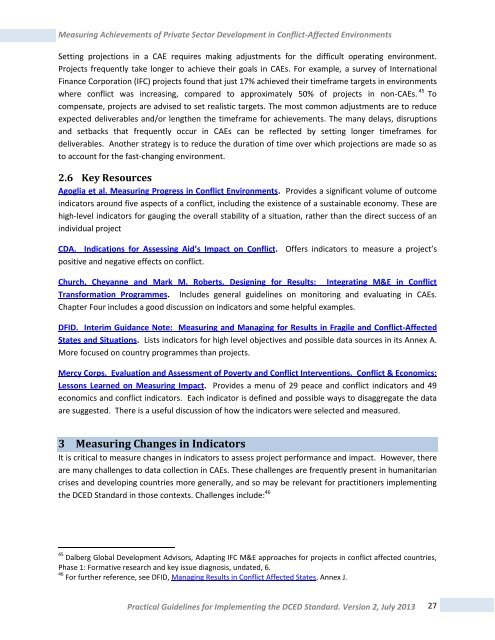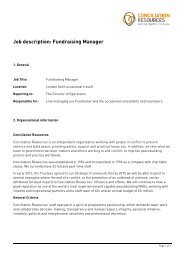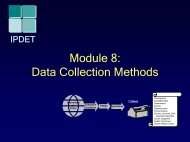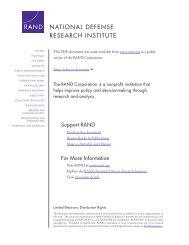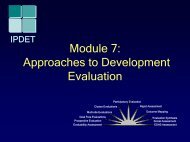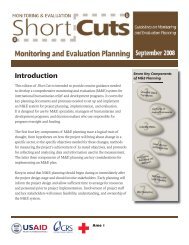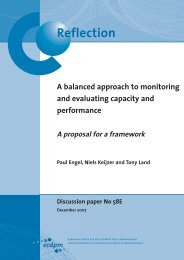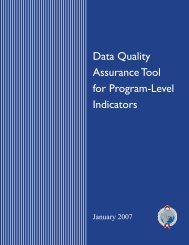Measuring Achievements of Private Sector Development in ... - DCED
Measuring Achievements of Private Sector Development in ... - DCED
Measuring Achievements of Private Sector Development in ... - DCED
You also want an ePaper? Increase the reach of your titles
YUMPU automatically turns print PDFs into web optimized ePapers that Google loves.
<strong>Measur<strong>in</strong>g</strong> <strong>Achievements</strong> <strong>of</strong> <strong>Private</strong> <strong>Sector</strong> <strong>Development</strong> <strong>in</strong> Conflict-Affected Environments<br />
Sett<strong>in</strong>g projections <strong>in</strong> a CAE requires mak<strong>in</strong>g adjustments for the difficult operat<strong>in</strong>g environment.<br />
Projects frequently take longer to achieve their goals <strong>in</strong> CAEs. For example, a survey <strong>of</strong> International<br />
F<strong>in</strong>ance Corporation (IFC) projects found that just 17% achieved their timeframe targets <strong>in</strong> environments<br />
where conflict was <strong>in</strong>creas<strong>in</strong>g, compared to approximately 50% <strong>of</strong> projects <strong>in</strong> non-CAEs. 45 To<br />
compensate, projects are advised to set realistic targets. The most common adjustments are to reduce<br />
expected deliverables and/or lengthen the timeframe for achievements. The many delays, disruptions<br />
and setbacks that frequently occur <strong>in</strong> CAEs can be reflected by sett<strong>in</strong>g longer timeframes for<br />
deliverables. Another strategy is to reduce the duration <strong>of</strong> time over which projections are made so as<br />
to account for the fast-chang<strong>in</strong>g environment.<br />
2.6 Key Resources<br />
Agoglia et al. <strong>Measur<strong>in</strong>g</strong> Progress <strong>in</strong> Conflict Environments. Provides a significant volume <strong>of</strong> outcome<br />
<strong>in</strong>dicators around five aspects <strong>of</strong> a conflict, <strong>in</strong>clud<strong>in</strong>g the existence <strong>of</strong> a susta<strong>in</strong>able economy. These are<br />
high-level <strong>in</strong>dicators for gaug<strong>in</strong>g the overall stability <strong>of</strong> a situation, rather than the direct success <strong>of</strong> an<br />
<strong>in</strong>dividual project<br />
CDA. Indications for Assess<strong>in</strong>g Aid’s Impact on Conflict. Offers <strong>in</strong>dicators to measure a project’s<br />
positive and negative effects on conflict.<br />
Church, Cheyanne and Mark M. Roberts. Design<strong>in</strong>g for Results: Integrat<strong>in</strong>g M&E <strong>in</strong> Conflict<br />
Transformation Programmes. Includes general guidel<strong>in</strong>es on monitor<strong>in</strong>g and evaluat<strong>in</strong>g <strong>in</strong> CAEs.<br />
Chapter Four <strong>in</strong>cludes a good discussion on <strong>in</strong>dicators and some helpful examples.<br />
DFID. Interim Guidance Note: <strong>Measur<strong>in</strong>g</strong> and Manag<strong>in</strong>g for Results <strong>in</strong> Fragile and Conflict-Affected<br />
States and Situations. Lists <strong>in</strong>dicators for high level objectives and possible data sources <strong>in</strong> its Annex A.<br />
More focused on country programmes than projects.<br />
Mercy Corps. Evaluation and Assessment <strong>of</strong> Poverty and Conflict Interventions. Conflict & Economics:<br />
Lessons Learned on <strong>Measur<strong>in</strong>g</strong> Impact. Provides a menu <strong>of</strong> 29 peace and conflict <strong>in</strong>dicators and 49<br />
economics and conflict <strong>in</strong>dicators. Each <strong>in</strong>dicator is def<strong>in</strong>ed and possible ways to disaggregate the data<br />
are suggested. There is a useful discussion <strong>of</strong> how the <strong>in</strong>dicators were selected and measured.<br />
3 <strong>Measur<strong>in</strong>g</strong> Changes <strong>in</strong> Indicators<br />
It is critical to measure changes <strong>in</strong> <strong>in</strong>dicators to assess project performance and impact. However, there<br />
are many challenges to data collection <strong>in</strong> CAEs. These challenges are frequently present <strong>in</strong> humanitarian<br />
crises and develop<strong>in</strong>g countries more generally, and so may be relevant for practitioners implement<strong>in</strong>g<br />
the <strong>DCED</strong> Standard <strong>in</strong> those contexts. Challenges <strong>in</strong>clude: 46<br />
45 Dalberg Global <strong>Development</strong> Advisors, Adapt<strong>in</strong>g IFC M&E approaches for projects <strong>in</strong> conflict affected countries,<br />
Phase 1: Formative research and key issue diagnosis, undated, 6.<br />
46 For further reference, see DFID, Manag<strong>in</strong>g Results <strong>in</strong> Conflict Affected States, Annex J.<br />
Practical Guidel<strong>in</strong>es for Implement<strong>in</strong>g the <strong>DCED</strong> Standard. Version 2, July 2013<br />
27


